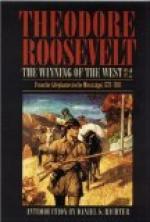The Battle.
The foes were now face to face. On the one side were the American backwoodsmen, under their own leaders, armed in their own manner, and fighting after their own fashion, for the freedom and the future of America; on the opposite side were other Americans—the loyalists, led by British officers, armed and trained in the British fashion, and fighting on behalf of the empire of Britain and the majesty of the monarchy. The Americans numbered, all told, about nine hundred and fifty men. [Footnote: Nine hundred and ten horsemen (possibly nine hundred, or perhaps nine hundred and thirty-three) started out; and the footmen who kept up were certainly less than fifty in number. There is really no question as to the American numbers; yet a variety of reasons have conspired to cause them to be generally greatly overstated, even by American historians. Even Phelan gives them fifteen hundred men, following the ordinary accounts. At the time, many outsiders supposed that all the militia who were at the Cowpens fought in the battle; but this is not asserted by any one who knew the facts. General J. Watts DePeyster, in the Mag. of Am. Hist. for 1880,—“The Affair at King’s Mountain,”—gives the extreme tory view. He puts the number of the Americans at from thirteen hundred to nineteen hundred. His account, however, is only based on Shelby’s later narratives, told thirty years after the event, and these are all that need be considered. When Shelby grew old, he greatly exaggerated the numbers on both sides in all the fights in which he had taken part. In his account of King’s Mountain, he speaks of Williams and the four hundred Flint Hill men joining the attacking body after, not before, the nine hundred and ten picked men started. But his earlier accounts, including the official report which he signed, explicitly contradict this. The question is thus purely as to the time of the junction; as to whether it was after or before this that the body of nine hundred actual fighters was picked out. Shelby’s later report contains the grossest self-contradictions.




